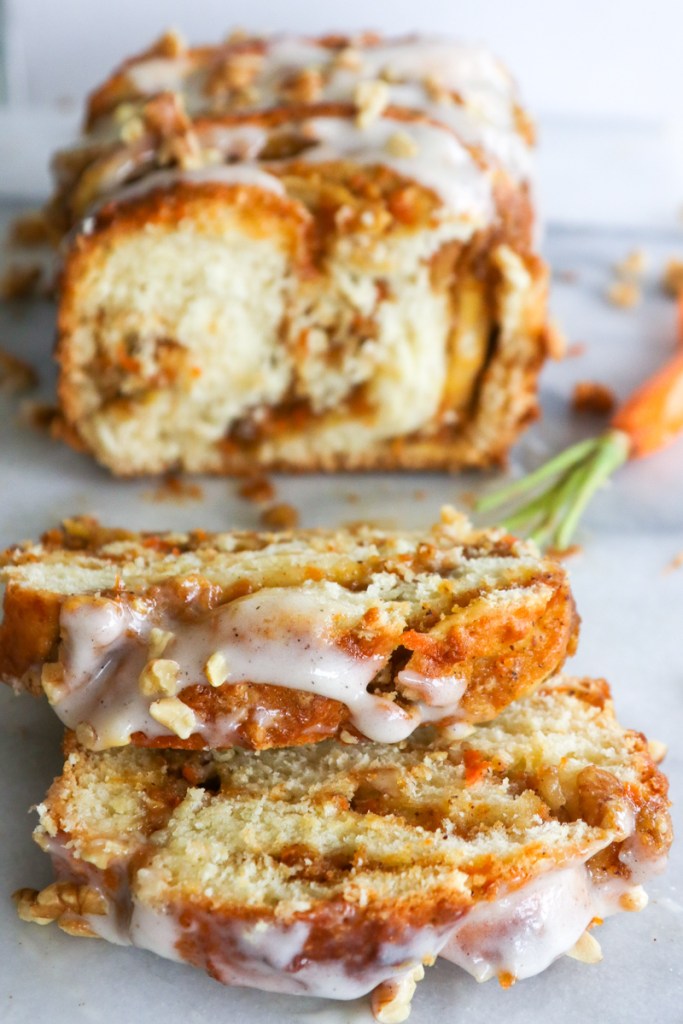Step up your babka game with Carrot Cake Babka with Cardamom Cream Cheese Drizzle!

I posted a tease of this babka on Instagram and asked you all to guess the Rosh Hashanah inspired flavor. Almost everyone guessed apples and honey! Which makes sense, because apples and honey are the go-to tag-team duo of symbols for the Jew Year. Like getting drunk hamantaschen for Purim or latkes for Hanukkah.


But Rosh Hashanah has a ton of symbolic foods! What could be more fun than that? (Sorry, my definition of fun in the pandemic has changed.) Here are a few Rosh Hashanah symbols you can use to incorporate into your menu. Some of these are because of what the food represents, and others are based on twists of the sound of the Hebrew. Sort of like puns!
What are Symbolic Rosh Hashanah Foods?
- Apples – hope and durability, often dipped in honey
- Honey and other sweet foods for a sweet New Year
- Round challah for the circle of life (cue The Lion King)
- Pomegranate and other new fruits for newness. The many pomegranate arils also represent the plentiful year ahead!
- Fish head– to symbolize the head of the year. We do not do this one. A cabbage head works here too!
- Beets or spinach or leeks or squash or dates – to get rid of our enemies. A lot of foods symbolize this because we have a lot of enemies maybe?
- Black-eyed peas or green beans – for a fruitful New Year
- Carrots – more blessings, less evil



You can check out my Rosh Hashanah recipes for lots of recipes with these symbols. Naturally I went for carrots here! You’re probably used to having carrots in your Rosh Hashanah tzimmes, which is a delicious choice too. I also have a Tzimmes Cake recipe which I love. So I though, how about babka? With brown sugar, butter, walnuts, cinnamon and other spices and carrots of course, it is everything you love about carrot cake in babka form.


And how about smothering it in a cardamom cream cheese drizzle?! It had to be done. It’s just science.

I think because there are carrots in here, you can eat this for breakfast, right? And because it’s a holiday? Right?

Fun story. Again, remember that my definition of fun is a little skewed these days. See that cute little carrot below? After I ate all cleaned up my babka, I saved that cute carrot because, well, it was adorable. My husband asked if that is why I saved it and I thought, he gets me. I couldn’t throw it away or even eat it! Just too adorable.

So we named our carrot pet Zany after zanahoria, which is carrot in Spanish. He became our pet for the week, randomly showing up in our bed or on the couch as we watched TV. Until my husband threw him away he disappeared while I was sleeping. Sad.

No carrot pets were harmed in the making of this babka.

Do you want a piece yet?!?

You can also make this babka in a wreath form. I did that too during one of my test batches! Perfect if you don’t have a loaf pan or if you like wreaths.

Carrot Cake Babka
Ingredients
Babka Dough
- 2¼ teaspoons aka 1 packet active dry yeast
- 2/3 cup warm whole milk 110ºF
- 3/4 cup granulated sugar
- 4-5 cups all-purpose flour plus extra for dusting
- 3 eggs at room temperature
- ½ teaspoon kosher salt
- 1 stick or ½ cup unsalted butter cut into chunks and softened
- Oil for greasing bowl grapeseed, sunflower, or vegetable oil
Carrot Cake Filling
- 1½ cups carrots, shredded and dried well
- 1½ cups brown sugar
- ½ cup all purpose flour
- 1 ½ tablespoons ground cinnamon
- ½ teaspoon ground ginger
- ½ teaspoon ground nutmeg
- ½ teaspoon ground cloves
- 1 teaspoon ground cardamom
- ½ teaspoon salt
- 4 tablespoons unsalted butter, softened
- 1 egg white (save the yolk for the glaze)
- 1 ½ cups toasted walnuts, chopped
Cream Cheese Cardamom Drizzle
- 4 ounces cream cheese
- 4 ounces unsalted butter, softened
- 1 cup powdered sugar
- 1 teaspoon ground cardamom
- 1-2 tablespoons milk
Instructions
Make the dough
- Let's start with the dough. In a large bowl or the bowl of a stand mixer, To make combine yeast, warm milk, and 2 teaspoons sugar and stir to dissolve. Wait 10 minutes; the mixture should get foamy and puff up. If it doesn’t, the milk was probably too hot, too cold, or the yeast is dead. Try again!
- Then add 4 cups of flour and remaining sugar, and stir to combine. Add eggs, one at a time, and mix with the dough hook attachment just until the dough comes together; this may take a couple of minutes. You can also do this by hand with a spoon, no fancy mixer needed!
- With the mixer on low, add salt, then butter, a little at a time, mixing until incorporated. Then, mix dough on medium speed or by hand for about 8–10 minutes until the dough is completely smooth, shiny, and slightly sticky. Make sure to scrape down the sides as you mix so everything gets incorporated. Add in more flour as you knead if it's very sticky to get the perfect texture.
- Coat a large bowl with oil (you can just clean out your mixer bowl and use that) and place dough inside, cover with plastic, and refrigerate for 12–24 hours, or until almost doubled in size. If you're in a hurry, let dough rise in a warm spot for 1 1/2 – 2 hours until doubled in size.
It's filling time
- When the dough is resting or just about ready, make the carrot cake filling. In a food processor, pulse the carrots until fine and remove as much water as possible. You can add the walnuts in at this point after the carrots to incorporate them into the filling, or sprinkle them on top like I did. Then add in the sugar, flour and spices and pulse. Then add in the butter and egg white and pulse to combine. You should have a thick paste. You can make this up to three days ahead of time.
Put it all together
- Divide the dough in 2 equal pieces and roll out one piece into a very thin 16 x 12-inch rectangle. You may have to let the dough come to room temperature a bit if it is hard to roll.
- Spread half of the carrot cake filling over the dough, leaving a ½-inch (1 cm) border. Sprinkle with half of the walnuts. Brush the farthest 12-inch end with water to help dough stick to itself. Then roll the dough up into a tight log using the shorter side so you have a 12-inch log. Place roll on a lightly floured baking sheet and refrigerate. Repeat with other dough and refrigerate both for 30 minutes.
- Grease two 9 x 5-inch (23 x 13 cm) loaf pans with oil and line the bottoms with parchment paper. (To get a piece that fits perfectly, trace the bottom of the pan on the parchment paper and then cutout. Magic!)
- Cut each log in half lengthwise and lay them next to each other. Pinch the top ends together and twist, keeping the cut sides up so you can see the carrot cake awesomeness. Place the babka carefully in the prepared loaf pan. Repeat with the other loaf. Cover both with damp paper towels and let rise in a warm place another about 1 hour.
Bake!
- Preheat oven to 350ºF with a rack placed in the middle.
- Whisk the egg yolk with a little water and brush all over the loaves. Bake loaves for 40–50 minutes, or until a thermometer reads 190ºF, turning halfway through baking. Cover lightly with foil if the top starts to brown too much. Once your babkas are done, let them cool in pan for 15 minutes, then remove and finish cooling on a cooling rack.
Drizzle
- While they are cooling, make your cream cheese cardamom drizzle by beating cream cheese and butter with a stand mixer. Carefully beat in powdered sugar and cardamom and then add in just enough milk to make it drizzly. Drizzle all over your cooled babkas and eat!
Notes
Love the swirls.














Amy,
Do you think I could use Almond Milk instead of whole milk? I’ve used it other bread recipes, but didn’t know if it would also work for this one.
Thank You….love your blog….love your creativity!
Janet
Thanks, Janet! I haven’t tried but if it worked in other yeast recipes then it should!
Amy, would you use half of the dough in a bundt, or all of it?
I haven’t made it in a bundt pan, just a round braided one, but I would think half would be best.
Ooooh I misread! That sounds even easier 🙂 Thanks!
I tried this recipe twice with absolutely zero luck. The dough didn’t rise at all overnight. In addition, it would be very useful in any bread making recipe to give a picture (or include in the video) an image of the pre-risen dough after kneading. Would also be useful to give weights and not cup measurements… Anyway, no idea what went wrong BOTH times as I make bread decently often. Cannot recommend this recipe.
If it didn’t rise at all, your yeast was probably dead. You could try to rise in a warmer place instead to see if that helps instead of the slow rise. Did you activate the yeast prior to adding the other ingredients? The dough looks pretty standard like challah/babka dough before risen, and then it doubles in size and appears lighter after rising. Like most challah doughs, you don’t need to measure the ingredients exactly for it to work. The flour amount can depending on the humidity, for example, which is why I say to add more flour as needed.